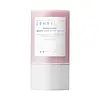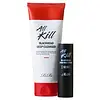What's inside
What's inside
 Key Ingredients
Key Ingredients

 Benefits
Benefits

 Concerns
Concerns

 Ingredients Side-by-side
Ingredients Side-by-side

Water
Skin ConditioningKaolin 8%
AbrasiveDipropylene Glycol
HumectantGlycerin
HumectantCI 77891
Cosmetic ColorantButylene Glycol
HumectantSodium Stearate
CleansingCentella Asiatica Extract 4.9%
Cleansing1,2-Hexanediol
Skin ConditioningPhaseolus Angularis Seed Powder
Aloe Barbadensis Leaf Extract
EmollientCetearyl Olivate
Propanediol
SolventSorbitan Olivate
EmulsifyingDimethicone
EmollientCI 77491
Cosmetic ColorantEthylhexylglycerin
Skin ConditioningSodium Phytate
Bentonite
AbsorbentIllite
AbrasiveMineral Salts
Skin ConditioningMontmorillonite
AbsorbentCalamine
AbsorbentWater, Kaolin 8%, Dipropylene Glycol, Glycerin, CI 77891, Butylene Glycol, Sodium Stearate, Centella Asiatica Extract 4.9%, 1,2-Hexanediol, Phaseolus Angularis Seed Powder, Aloe Barbadensis Leaf Extract, Cetearyl Olivate, Propanediol, Sorbitan Olivate, Dimethicone, CI 77491, Ethylhexylglycerin, Sodium Phytate, Bentonite, Illite, Mineral Salts, Montmorillonite, Calamine
Water
Skin ConditioningSodium Stearate
CleansingPropylene Glycol
HumectantMethylpropanediol
SolventCharcoal Powder
AbrasiveBis-PEG-18 Methyl Ether Dimethyl Silane
EmollientSilica
AbrasivePolysorbate 20
EmulsifyingMicrocrystalline Cellulose
AbsorbentLactose
HumectantBentonite
AbsorbentJuglans Regia Shell Powder
AbrasiveCellulose
AbsorbentVitis Vinifera Fruit Extract
Skin ConditioningDiospyros Kaki Leaf Extract
Skin ProtectingPolygonum Cuspidatum Root Extract
AntioxidantCoffea Arabica Seed Extract
MaskingCarthamus Tinctorius Flower Extract
Skin ConditioningZanthoxylum Schinifolium Leaf Extract
Skin ConditioningCastanea Crenata Shell Extract
Skin ConditioningCamellia Sinensis Leaf Extract
AntimicrobialCitrus Aurantium Dulcis Fruit Extract
MaskingPyrus Malus Fruit Extract
Skin ConditioningCitrus Limon Fruit Extract
MaskingCitrus Aurantifolia Fruit Extract
Skin ConditioningOryza Sativa Extract
AbsorbentGlycine Soja Seed Extract
Skin ConditioningSesamum Indicum Seed Extract
Skin ConditioningMelaleuca Alternifolia Leaf Extract
PerfumingAloe Ferox Leaf Extract
Skin ConditioningChamomilla Recutita Extract
Skin ConditioningLavandula Angustifolia Flower Extract
CleansingJojoba Esters
EmollientButylene Glycol
HumectantHydroxypropyl Methylcellulose
Emulsion StabilisingAscorbyl Palmitate
AntioxidantSodium Hyaluronate
HumectantCitric Acid
BufferingAscorbic Acid
AntioxidantBetaine Salicylate
AntimicrobialSalicylic Acid
MaskingGluconolactone
Skin ConditioningEthylhexylglycerin
Skin Conditioning1,2-Hexanediol
Skin ConditioningTocopheryl Acetate
AntioxidantChlorphenesin
AntimicrobialPhenoxyethanol
PreservativeCI 73360
Cosmetic ColorantParfum
MaskingWater, Sodium Stearate, Propylene Glycol, Methylpropanediol, Charcoal Powder, Bis-PEG-18 Methyl Ether Dimethyl Silane, Silica, Polysorbate 20, Microcrystalline Cellulose, Lactose, Bentonite, Juglans Regia Shell Powder, Cellulose, Vitis Vinifera Fruit Extract, Diospyros Kaki Leaf Extract, Polygonum Cuspidatum Root Extract, Coffea Arabica Seed Extract, Carthamus Tinctorius Flower Extract, Zanthoxylum Schinifolium Leaf Extract, Castanea Crenata Shell Extract, Camellia Sinensis Leaf Extract, Citrus Aurantium Dulcis Fruit Extract, Pyrus Malus Fruit Extract, Citrus Limon Fruit Extract, Citrus Aurantifolia Fruit Extract, Oryza Sativa Extract, Glycine Soja Seed Extract, Sesamum Indicum Seed Extract, Melaleuca Alternifolia Leaf Extract, Aloe Ferox Leaf Extract, Chamomilla Recutita Extract, Lavandula Angustifolia Flower Extract, Jojoba Esters, Butylene Glycol, Hydroxypropyl Methylcellulose, Ascorbyl Palmitate, Sodium Hyaluronate, Citric Acid, Ascorbic Acid, Betaine Salicylate, Salicylic Acid, Gluconolactone, Ethylhexylglycerin, 1,2-Hexanediol, Tocopheryl Acetate, Chlorphenesin, Phenoxyethanol, CI 73360, Parfum
 Reviews
Reviews

Ingredients Explained
These ingredients are found in both products.
Ingredients higher up in an ingredient list are typically present in a larger amount.
1,2-Hexanediol is a synthetic liquid and another multi-functional powerhouse.
It is a:
- Humectant, drawing moisture into the skin
- Emollient, helping to soften skin
- Solvent, dispersing and stabilizing formulas
- Preservative booster, enhancing the antimicrobial activity of other preservatives
Bentonite is an aluminium phyllosilicate clay with great absorbent properties. The name 'bentonite' comes from the area where the largest source is found: Fort Benton, Wyoming.
As a clay, bentonite is often used to absorb excess oil and provide exfoliation. It has also been shown to have some antibacterial and anti-inflammatory properties. Studies show bentonite was effective at calming dermatitis from poison ivy and in diaper dermatitis of infants. Bentonite has also been shown to act as a barrier against toxic compounds on your skin.
Sunscreens containing bentonite display higher water resistance and stay on the skin for much longer. The sunscreens containing bentonite also show higher potency and UV light absorbtion.
Bentonite is naturally created from volcanic ash and several natural weathering/hydrothermal processes.
A common usage of bentonite is removing excess protein from white wines. Bentonite contains a property of being able to absorb large amounts of protein from aqueous solutions.
Phyllosilicate clay has a structure formed by sheets.
Learn more about BentoniteButylene Glycol (or BG) is used within cosmetic products for a few different reasons:
Overall, Butylene Glycol is a safe and well-rounded ingredient that works well with other ingredients.
Though this ingredient works well with most skin types, some people with sensitive skin may experience a reaction such as allergic rashes, closed comedones, or itchiness.
Learn more about Butylene GlycolEthylhexylglycerin (we can't pronounce this either) is commonly used as a preservative and skin softener. It is derived from glyceryl.
You might see Ethylhexylglycerin often paired with other preservatives such as phenoxyethanol. Ethylhexylglycerin has been found to increase the effectiveness of these other preservatives.
Sodium stearate is the sodium salt of stearic acid.
The structure of sodium stearate makes it both a cleanser and emulsifier. As a cleanser, it helps dissolve dirt, oil, and other pollutants. As an emulsifier, it helps prevent ingredients from separating. This adds stability to the formula.
Water. It's the most common cosmetic ingredient of all. You'll usually see it at the top of ingredient lists, meaning that it makes up the largest part of the product.
So why is it so popular? Water most often acts as a solvent - this means that it helps dissolve other ingredients into the formulation.
You'll also recognize water as that liquid we all need to stay alive. If you see this, drink a glass of water. Stay hydrated!
Learn more about Water